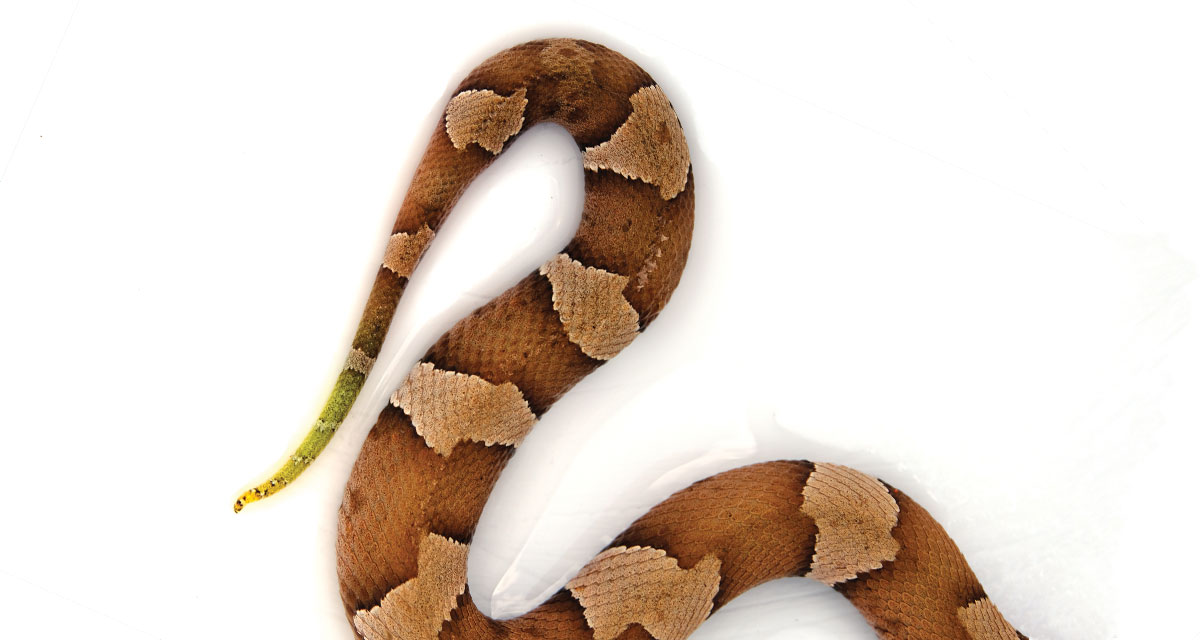Thrilling tales of survival often begin with a dangerous animal encounter. Sitting rooted at the edge of our seat, heart pumping, we’ve listened to survivalists recount their moments far from home; yet, in 2019, Winston-Salem news stations reported that a Piedmont Triad woman’s five-month-old puppy was being walked on a leash in his neighborhood and mistook a baby copperhead for a branch. It struck the dog in the mouth and five other regions. Quick action and immediate care ensured the puppy lived. It’s usually during the peaceful moments of the day, perhaps when we’re walking among green foliage, whether it’s a sidewalk or trail, when unsuspecting situations arise. From unidentifiable snakes to predators lurking in dark or camouflaged areas, primal terror exists when it’s our story. As logging forces animals from their natural habitats into public locations, it’s vital to research the identification of harmful predators and learn how to flee situations in safety.
Snakes
The Hollywood Western movie or television program often gives viewers the “what not to do” when encountering a snake or suffering a bite. Number one—don’t panic! Approximately six people die each year from over 8,000 venomous snakebites. Allow the wound to bleed freely for 30 minutes and seek immediate medical attention.
The Piedmont Triad has roughly 20 species of non-venomous snakes with rounded heads that control rodent populations while avoiding human interaction. On the other hand, we also have two types of venomous snakes, both possessing the same identifying mark—a triangular head.
- Northern Copperhead: Its prominent features are the horizontal hourglass pattern of copper, red, and brown coloring. Known for its nocturnal tendencies and preference for grassy fields or bodies of water, the three-foot snake at maturity holds its head at a 45-degree angle, ready to strike.
If you have a pool, creek nearby, or have tall weeds, it’s vital to eliminate or patrol these cozy locations where the copperhead may create a nest or linger across seasons. These snakes do not act aggressively towards humans, but children, especially, need to know how to respond to a snake sighting.
- Timber Rattlesnake: Measuring between one to six feet in length, the rattlesnake also has a horizontal hourglass pattern; colors range from brown, grey, green, to black, with a spiraled rattle-tail. The rattlesnake coils in crevices for warmth and prefers locations rodents frequent.
Consider walking with a long stick, especially near rocks, shrubs, or brush. If You sit down on a tree stump or log, always check the inside or surroundings first. Remember, rattlesnakes can swim; so, be careful when crossing creeks.
The Black Bear
As natural habitats diminish, the location of black bear sightings in the Piedmont Triad has grown to cover 60% of the state. The black bear prefers non-aggression towards humans; however, they can become bold when consistent food supplies, such as pet food, garbage, wildlife seeds, are available.
Do not panic if a bear is in your sight or standing on its hind legs; it’s attempting to see or smell. Immediately call 911 and go indoors. Always secure trash in a can and clean all food and grease from barbeque grills after every use. Eliminating food odors will deter bears from investigating your property.
Southern Black Widow Spider
Remember to wear gloves when reaching a hand into dark corners, woodpiles, tree stumps, and overgrown areas, otherwise, you’ll possibly disturb the web of the black widow spider. Entirely black, except for the spherical abdomen containing a red hourglass marking, she’ll hang upside down from her web. Her bite contains poison, causing respiration difficulties, lesions, and possibly paralysis. Males are much smaller and are either gray or brown.
Mixing white vinegar and dish soap to clean outdoor furniture and planting fragrant herbs, such as peppermint and lavender, are excellent repellants for these creatures.
A Dog’s Predator
The canine is a curious animal, willing to tempt fate by barking and drawing closer. Raccoons, coyotes, bobcats, and foxes are fierce creatures, usually hunting in packs and known to kill household pets. Possums will play dead as a defense mechanism, while squirrels will retaliate if hunted.
Fencing helps protect pets during the day, and periodic checks, if possible, will also ensure their safety. Many of the 21 animals capable of hurting dogs are nocturnal. Keep family pets indoors to prevent an animal attack, especially at night.
As you wander from backyard to neighborhood streets or travel for a day on weekend trips, be aware of what lurks beyond your footsteps, but most importantly, also take time to look up!























